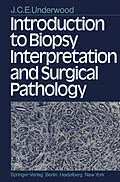This book is primarily addressed to the needs of the trainee histopathologist. It is intended to bridge that gap between the descriptive histopathology taught as part of the undergraduate medical curriculum and the interpretative skills required of the diagnostician. My object is to convey the basic general principles, in theory and practice. Books are, however, only adjuncts to practical experience and not substitutes for it. Indeed, to obtain the maximum benefit from this book it is essential that the reader is actively involved in the work of a diagnostic laboratory. Only in this way can the trainee become thoroughly conversant with the rudiments of biopsy interpretation. To retain detailed knowledge of the histological appearances of the plethora of diseases and their permutations to which humans are subject is beyond the mental resources of most individuals. For this reason, histopathologists probably refer to books more often than do most other specialists. This book aims to provide a core of knowledge sufficient to master the fundamental aspects, while still encouraging the intelligent use of all those indispensable atlases, monographs, and fascicles for which there is no substitute.
Inhalt
1 Diagnostic Histopathology.- A. Origins of Histopathology.- B. The Objectives of Histopathology.- I. Clinical Diagnosis.- II. Epidemiology.- III. Treatment Selection and Monitoring.- IV. Clinical Research.- V. Autopsies and Clinico-pathological Correlation.- C. The Histopathological Diagnosis.- I. Diagnosis and Disease.- II. Diagnostic Processes.- III. Diagnostic Fallibility.- IV. Quality Assessment and Control.- 2 Macroscopy, Microscopy, and Sampling.- A. Sampling Error.- B. Sampling Biopsies and Surgical Resections.- I. Suspected or Proven Neoplasia.- II. Ischaemic and Vascular Lesions.- III. Infections and Inflammatory Lesions.- IV. Metabolic and Degenerative Diseases.- C. Specific Types of Biopsy.- I. Needle Biopsies.- II. Mucosal Biopsies.- III. Currettings.- IV. Cone Biopsies.- D. Imprints, Smears, and Squashes.- E. Living Cells.- F. Specimen Radiology.- G. Section Thickness.- I. Thick Sections.- II. Thin Sections.- H. Information and Magnification.- 3 The Use of Stains.- A. Principles of Staining.- B. Indications for Special Stains.- C. Immunofluorescence and Immunohistochemistry.- D. Identification of Specific Substances and Cells.- I. Connective Tissues.- II. Carbohydrates.- III. Nucleic Acids.- IV. Fats.- V. Minerals and Pigments.- VI. Organisms.- VII. Specific Cells.- E. Autoradiography.- 4 Interpretation of Histological Appearances.- A. Artifact of Sections.- B. Basic Microscopy.- C. Methods of Interpretation.- I. Heuristic Analysis.- II. Pattern Recognition.- III. Clinico-pathological Integration.- D. Morphology of Disease Processes.- I. Evolution of Lesions.- II. Modification by Treatment.- III. Significance of Specific Morphological Features.- IV. Morphological Overlap Between Diseases.- 5 Borderline Lesions, Pseudomalignancy, and Mimicry.- A. Borderline Lesions.- I. Discrete Versus Continuous Diagnostic Categories.- II. Use of Criteria.- B. Mimicry of Histological Features.- C. Pseudomalignancy and Related Diagnostic Problems.- I. Skin.- II. Soft Tissues.- III. Lymphoid Tissues.- IV. Bone.- V. Breasts.- VI. Urinary Tract.- VII. Thyroid.- VIII. Male Genitalia.- IX. Female Genital Tract.- X. Gastrointestinal Tract.- XI. Respiratory Tract.- XII. Serosal Surfaces.- XIII. Central Nervous System.- 6 Rapid Frozen Section Diagnosis.- A. Clinical Indications.- B. Methods.- C. Interpretation.- D. Common Applications.- I. Breast Lesions.- II. Thyroid.- III. Parathyroid Glands.- IV. Gastrointestinal Tract.- V. Respiratory Tract.- VI. Urinary Tract.- VII. Bone and Soft Tissues.- VIII. Skin.- E. Reliability.- 7 Diagnostic Electron Microscopy.- A. Principles of Transmission Electron Microscopy.- I. The Electron Microscope.- II. Specimen Processing.- B. Diagnostic Value of Transmission Electron Microscopy.- I. Renal Disease.- II. Tumour Histogenesis.- III. Virus Identification.- IV. Miscellaneous Applications.- C. Scanning Electron Microscopy.- D. X-ray Microanalysis.- 8 Quantitative Methods.- A. Stereological Principles.- B. Stereological Methods.- I. Volumetric Analysis.- II. Surface Area.- III. Surface-to-Volume Ratios.- IV. Particle Size and Density.- C. Automatic and Semi-Automatic Image Analysis.- D. Microspectrophotometry and Flow Microfluorimetry.- E. Practical Applications.- I. Metabolic Bone Disease.- II. Jejunal Biopsies.- III. Respiratory Tract.- IV. Tumours.- 9 Reporting and Classification of Biopsy Diagnoses.- A. The Biopsy Report.- I. Gross Description.- II. Histology.- III. Other Investigations.- IV. Summary.- B. Disease Classifications.- I. "Lumping" and "Splitting".- II. Nomenclature and Codes.- III. Problems in Tumour Classification and Grading.- C. Data Storage and Retrieval.- D. Clinical Assimilation.
